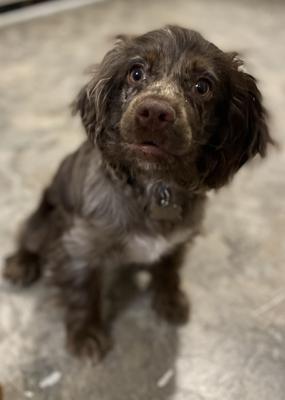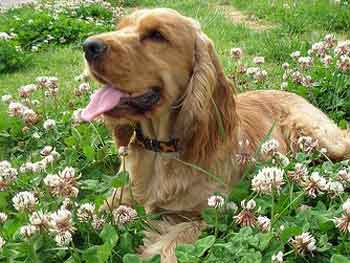- Home
- Grooming a Cocker Spaniel
Our Ultimate Guide To Grooming A Cocker Spaniel For Best Results!
Grooming a Cocker Spaniel isn't just about brushing and bathing your dog; it's about much more.
Dog grooming involves checking your pet's ears, eyes, claws and teeth, and it's essential for your Spaniel's health.
The grooming process also involves keeping a close eye on your dog's coat (and skin) in case any wee beasties decide to take up residence within.
Read on to learn how to groom a Cocker Spaniel.
English Cocker Spaniel Grooming And Health
Cocker Spaniels are made for grooming, don't you think?
It's probably those tantalisingly long ears; you can't help but want to stroke and brush them because they're so tactile, soft and silky!
This is just as well as your Cocker Spaniel will need regular grooming to keep his coat clean, shining and manageable because, if left to their own devices, Cocker Spaniel coats can quickly become coarse and matted.
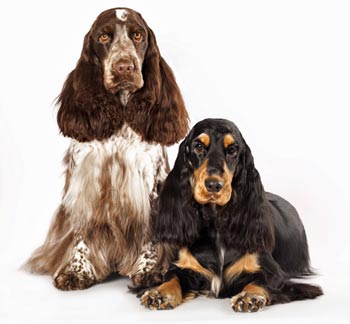 These Cocker Spaniels are beautifully groomed!
These Cocker Spaniels are beautifully groomed!How To Groom A Cocker Spaniel
You'll find lots of helpful valuable grooming tips below.
Follow the links to the right of the relevant photos to see the page you're looking for. Once you've read the article, return here and read the next one.
Cocker Spaniel Grooming Tools
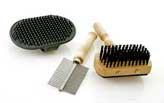 Basic Grooming Tools
Basic Grooming ToolsYou'll need the essential cocker spaniel grooming tools to help you get the job done quickly and professionally. You don't need a lot; you can get away with only the basics if you're on a budget!
Brushing Your Dog
 Just Groomed!
Just Groomed!There's nothing more beautiful than a freshly brushed Cocker Spaniel.
Learn about brushing your dog and the best way to remove tats, tangles, and matting from your Cocker's coat.
Bathing Your Puppy For The First Time
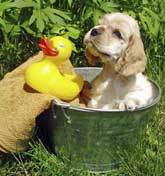 Bathing Your Puppy!
Bathing Your Puppy!Don't traumatise your puppy by putting him straight into the bath; you may scare him and put him off bath-time for life.
Here's a step-by-step guide to bathing your Cocker puppy for the very first time - take it slowly and gently!
Bathing Your Dog
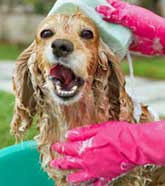 Yippee - Bath Time!
Yippee - Bath Time!Bath time can be and should be fun.
Learn how bathing your Cocker Spaniel doesn't have to lead to tears or tantrums (either from you or your pet!)
Clipping Your Dog's Nails
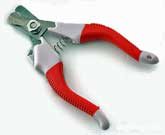 Nail Clippers
Nail ClippersLearn How To Clip Your Pet's Nails
Get this wrong, and he'll never let you near his paws again - get it right, however, and it will be a snip!
Dew Claw Removal
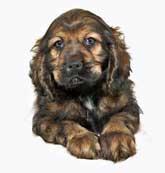 Dewclaw? What's that?
Dewclaw? What's that?Most breeders remove their puppies' dew claws when they are young, so you may not even realise that your pet had an extra claw.
Learn more about dewclaws here.
How To Clean Your Dog's Ears
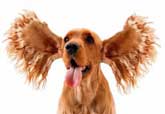 Look, Clean Ears!
Look, Clean Ears!This step-by-step guide to cleaning your Cocker Spaniel's ears is a must and can save you money by keeping him away from the vets.
Brushing Your Dog's Teeth for Best Results!
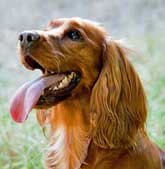 Look - Clean Teeth!
Look - Clean Teeth!Dental hygiene is essential to any Cocker Spaniel grooming routine; it will keep your pet's breath sweet and help keep his teeth and gums healthy.
Learn why brushing your dog's teeth is essential.
Brushing Your Puppy's Teeth
 Oops! I Ate A Sweetie!
Oops! I Ate A Sweetie!As new puppy owners, we should get into the habit of cleaning our puppy's teeth.
Understand why and the best way to brush puppy teeth.
My Dog Has Really Bad Breath!
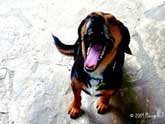 Doggie Bad Breath
Doggie Bad BreathIf your dog's bad breath isn't caused by poor dental hygiene, it may be a symptom of an underlying health problem. Learn more about foul doggie breath and how to cure it.
Learn About Your Dog's Anal Glands
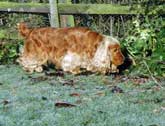 My Glands Are Fine!
My Glands Are Fine!Learn about your dog's anal sacs, what they are, what can go wrong with them and how to spot the signs when these anal sacs/glands become infected.
Expressing Your Dog's Anal Glands
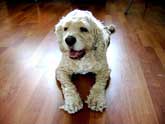 My Glands Are Blocked!
My Glands Are Blocked!How To Clear Your Spaniel's Anal Glands:
If your dog's anal glands are impacted, you can quickly learn how to express them yourself or ask your groomer to do it for you.
How To Choose A Dog Groomer
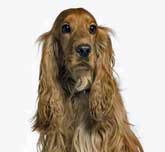 Choose A Good Groomer
Choose A Good GroomerYou wouldn't trust your Cocker Spaniel with any old groomer, would you? Didn't think so!
Know what to look for and which questions to ask a dog groomer.
What Are The Benefits of Grooming a Cocker Spaniel?
Grooming a Cocker Spaniel isn't just about keeping your pet looking good.
It's essential for your Spaniel's health because it allows you to look for fleas and ticks, grazes, sores, grass seeds, matting, cuts, lumps and skin problems and deal with them before they turn nasty.
It's also an excellent opportunity to examine those beautifully pendulous ears for signs of excess bacteria or infection and check their eyes for early signs of problems.
Besides health and the obvious visual benefits to your dog, grooming your Cocker Spaniel has a few additional benefits for owners.
It can help us relax and unwind and can help strengthen the bond between us and our pets.
Grooming also (subconsciously) helps us reinforce our position as the alpha male or female because dogs don't usually allow other members of the pack, lower in rank, to groom them.
Do Cocker Spaniels Shed Much?
Cockers are moderate shedders; however, some shed more than others, and some don't shed at all!
You can read more about shedding and what our visitors say about their experience with their dogs' shedding problems here.
It's Essential To Begin Grooming A Puppy Early!
Unfortunately, not all dogs enjoy being groomed, but it will be much easier if you begin grooming your Spaniel when he's a puppy to help him get used to and enjoy the process.
Grooming a puppy will involve 'play grooming' to familiarise your pup with brushes, combs, scissors, etc., because he won't yet have any feathers, and his coat will still be pretty short.
Play grooming while your Cocker is very young will help him become familiar with each grooming activity. So that when your puppy grows his feathers and needs to be groomed for real, there won't be any surprises; it will be a walk in the park!
Begin now if you haven't already.
Cocker Spaniel Grooming Cuts
Although I often groom my Cocker Spaniel myself, I never cut or trim his coat; I'm not skilled enough.
The English Cocker Spaniel Club of America has an interesting, well-illustrated article on grooming cuts.
It is a beginner's guide to grooming an English Cocker Spaniel. It shows, step by step, how to groom a Cocker Spaniel, and I'm sure you will find it very interesting!
Conclusion: Grooming A Cocker Spaniel
Grooming a Cocker Spaniel can be challenging and reasonably time-consuming, especially if your dog enjoys a daily romp around the fields and often returns home rather grubby!
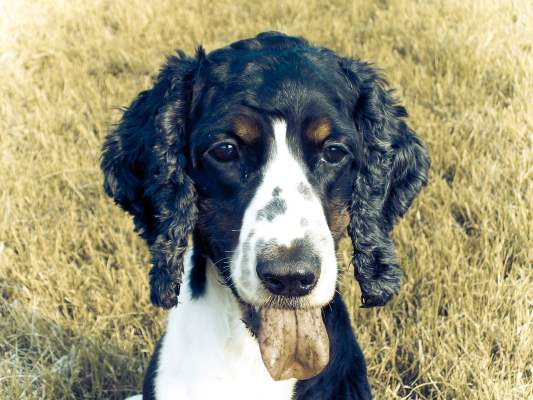 This little monkey has been eating soil!
This little monkey has been eating soil!Cocker coats are a magnet for burrs, seeds, and bits of twig (in fact, anything!), so their coats must be brushed often to keep them looking beautiful.
Their ears must be inspected often and brushed to avoid matting and ear infections.
Okay, so it might be a little time-consuming, but besides helping to make your Cocker Spaniel look great, regular grooming will also help keep his skin, nails, ears, and eyes in excellent health.
As an added benefit, grooming your Cocker Spaniel is relaxing for you both and helps reinforce the bond with your Cocker!
That's definitely well worth the effort involved - don't you agree?
Grooming a Cocker Spaniel : Best Practice
Watch this lovely, well-behaved Cocker Spaniel being groomed.
It will give you a flavour of what you're in for. Unfortunately, not all Cockers are as patient as Arrow, and the groomer makes it look easy!
I hope you enjoy it.
Please leave feedback below and let us know what you think about this page.
Cocker Spaniel Grooming: Visitor Questions
My Cocker Spaniel's Ears
By: Jean
From: KY
Hi! My dog has a solid mass of hair behind his ears, which I can't seem to get to. Is this common? Will it harm him, and how can I get rid of this mass of hair?
Reply from Pauline (Website Owner)
Grooming a Cocker Spaniel Ears
 Grooming cocker spaniels ears
Grooming cocker spaniels earsHi!
Cocker Spaniels often develop tats in the feathers on their ears, particularly behind and underneath the ear.
Mats can trap all sorts of vegetation (twigs, seeds, etc.), which can cause skin irritation and/or scratch and break the skin.
An infection can set in once your dog's skin has been broken.
Grooming dogs is necessary to keep their coat soft and free of tats.
They can soon develop into thick, stubborn mats if they aren't removed quickly as soon as you discover them. Find them early and brush them out.
If your Cocker Spaniel gets a mat in his coat, you will have several options.
You can cut the mat out or cut into it (in thin strips) and then try to brush each strip out gently with a slicker brush.
It's unlikely that you will be able to comb out a solid mat in its entirety.
If you're struggling, take your Cocker Spaniel to a professional dog groomer or vet and ask them to remove the mats for you.
Make sure you choose a groomer with plenty of experience with Cockers - learn how to choose a dog groomer here.
Ongoing, I recommend you brush your Cocker's ears every other day or at least twice each week.
Use a slicker brush first, brush both sides of his ears, and remember to brush under the base of his ear and around the ear opening.
Use a comb when no more fur is left behind in the brush.
Your Cocker Spaniel's ears can be sensitive. I'm sure I don't need to advise you to take great care and be very gentle!
I hope this advice helps - good luck!
Visitor Comments:
Grooming A Cocker Spaniel's Ears
My Cocker Spaniel's Ears
By: Anonymous
I do that for my dog, but I brush his ears daily because we both enjoy it. I love to sit with my dog and groom him; he revels in the closeness.
The underside of his ears is always the worst, and if I left them, he would definitely get mats - that's why I brush them every day.
Other places where my dog's fur seems to get matted are his butt and in between his toes. That's why I brush these areas more often.
Unfortunately, he doesn't really like his butt brushed (well, who does?), and he tolerates me brushing his paws; he doesn't like it, but he lets me do it anyway.
I love my cocker spaniel to bits!
Cocker Ears
By: Morgan
Yea - it really is good advice to keep it short.
Photo Credits for Grooming A Cocker Spaniel:
1. Liliya
Kulianionak at https://www.dreamstime.com/stock-image-couple-english-cocker-spaniel-image23622081
2. Ronnie Meijer at https://www.flickr.com/photos/sweetron1982/4891561118





